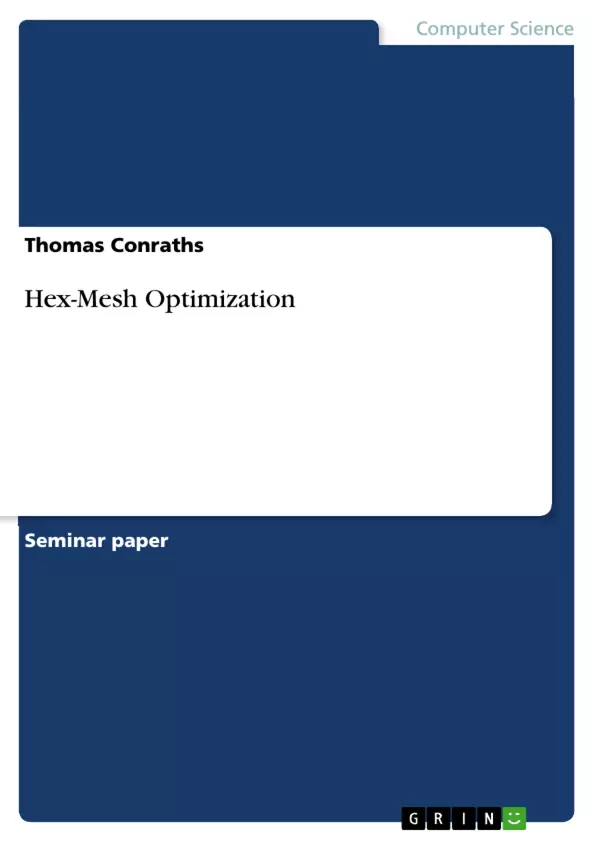The commonly chosen object representations in computer based simulation applications are hexahedral meshes. As their quality strongly influences the outcome of a simulation, hex-mesh optimization is an important aspect of creating a suitable input mesh for such simulations.
Practical hex-mesh optimization via edge-cone rectification is an optimization approach that converts the direct hexahedra optimization problem to an easier to solve scenario. Comparisons have shown that this approach is able to successfully generate high-quality hex-meshes in cases where other approaches fail.
Inhaltsverzeichnis (Table of Contents)
- Introduction
- Object Representation
- Mesh Types
- Properties in the Context of Simulation
- Mesh Creation
- Hex-Mesh Optimization
- Related Work
- Optimization via Edge-Cone Rectification
- Basic Problem Definition
- Cone Shape Optimization
- Additional Constraints
- Optimized Boundary Surface Preservation
- Complete Formulation
- Results
- Outcome Quality
- Comparison
- Conclusion
Zielsetzung und Themenschwerpunkte (Objectives and Key Themes)
This work explores practical approaches to optimizing hexahedral meshes, which are commonly used in computer-based simulation applications. The primary objective is to demonstrate the effectiveness of a new optimization method called "edge-cone rectification" for generating high-quality hexahedral meshes. This method tackles the challenges of hexahedral mesh optimization by converting the complex problem into a simpler form.
- Hexahedral Mesh Optimization
- Edge-Cone Rectification
- Object Representation in Simulation
- Mesh Quality and Simulation Accuracy
- Comparison of Optimization Approaches
Zusammenfassung der Kapitel (Chapter Summaries)
Chapter 2 delves into the concept of object representation in computer graphics, focusing on polyhedral meshes. It discusses different mesh types, including structured and unstructured grids, and explores the properties of these meshes in the context of simulation, highlighting their influence on simulation accuracy. The chapter also provides an overview of common methods for creating initial hexahedral meshes.
Chapter 3 concentrates on the optimization of hexahedral meshes (hex-meshes). It introduces various existing optimization methods and their limitations, emphasizing the need for approaches that can handle complex scenarios and produce high-quality, inversion-free meshes. The chapter then presents a detailed explanation of the edge-cone rectification optimization method, emphasizing its ability to address the limitations of other techniques.
Chapter 4 showcases the results of applying the edge-cone rectification method, demonstrating its effectiveness in generating high-quality hex-meshes. It compares the outcome of this approach to other existing methods, highlighting its advantages in terms of mesh quality and ability to handle difficult scenarios.
Schlüsselwörter (Keywords)
The primary focus of this work lies on hexahedral mesh optimization, specifically using the edge-cone rectification method. Key terms and concepts include object representation, simulation, finite element method, mesh quality, inversion-free meshes, and comparison of optimization approaches.
- Quote paper
- Thomas Conraths (Author), 2016, Hex-Mesh Optimization, Munich, GRIN Verlag, https://www.grin.com/document/1194366



